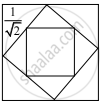Advertisements
Advertisements
Question
The midpoints of the sides of a square of side 1 are joined to form a new square. This procedure is repeated indefinitely. Find the sum of the perimeters of all the squares
Solution

Perimeter of 1st square = 4
Perimeter of 2nd square = `4(1/sqrt(2))`
Perimeter of 3rd square = `4(1/2)`
and so on.
∴ Sum of the perimeters of all the squares
= `4 + 4(1/sqrt(2)) + 4(1/2) + ...`
= `4(1 + 1/sqrt(2) + (1/sqrt(2))^2 + ...)`
The terms `1,1/sqrt(2), (1/sqrt(2))^2, ...` are in G.P.
∴ a = 1, r = `1/sqrt(2)`
Since, |r| = `|1/sqrt(2)| < 1`
∴ sum to infinity exists.
∴ Sum of the perimeters of all the squares
= `4(1/(1 - 1/sqrt(2)))`
= `(4sqrt(2))/(sqrt(2) - 1)`
APPEARS IN
RELATED QUESTIONS
Which term of the following sequence:
`sqrt3, 3, 3sqrt3`, .... is 729?
Find the sum of the products of the corresponding terms of the sequences `2, 4, 8, 16, 32 and 128, 32, 8, 2, 1/2`
Find four numbers forming a geometric progression in which third term is greater than the first term by 9, and the second term is greater than the 4th by 18.
Show that the ratio of the sum of first n terms of a G.P. to the sum of terms from (n + 1)th to (2n)th term is `1/r^n`.
The sum of two numbers is 6 times their geometric mean, show that numbers are in the ratio `(3 + 2sqrt2) ":" (3 - 2sqrt2)`.
A G.P. consists of an even number of terms. If the sum of all the terms is 5 times the sum of terms occupying odd places, then find its common ratio.
Find:
the ninth term of the G.P. 1, 4, 16, 64, ...
Find :
the 12th term of the G.P.
\[\frac{1}{a^3 x^3}, ax, a^5 x^5 , . . .\]
Find :
the 10th term of the G.P.
\[\sqrt{2}, \frac{1}{\sqrt{2}}, \frac{1}{2\sqrt{2}}, . . .\]
Which term of the G.P. :
\[\sqrt{3}, 3, 3\sqrt{3}, . . . \text { is } 729 ?\]
If the G.P.'s 5, 10, 20, ... and 1280, 640, 320, ... have their nth terms equal, find the value of n.
If 5th, 8th and 11th terms of a G.P. are p. q and s respectively, prove that q2 = ps.
The 4th term of a G.P. is square of its second term, and the first term is − 3. Find its 7th term.
Evaluate the following:
\[\sum^n_{k = 1} ( 2^k + 3^{k - 1} )\]
Find the sum of the following serie to infinity:
\[1 - \frac{1}{3} + \frac{1}{3^2} - \frac{1}{3^3} + \frac{1}{3^4} + . . . \infty\]
Find the sum of the following serie to infinity:
\[\frac{1}{3} + \frac{1}{5^2} + \frac{1}{3^3} + \frac{1}{5^4} + \frac{1}{3^5} + \frac{1}{56} + . . . \infty\]
If a, b, c are in G.P., prove that log a, log b, log c are in A.P.
Find k such that k + 9, k − 6 and 4 form three consecutive terms of a G.P.
If a, b, c, d are in G.P., prove that:
(b + c) (b + d) = (c + a) (c + d)
If a, b, c are in G.P., prove that the following is also in G.P.:
a2, b2, c2
If a, b, c are in G.P., prove that the following is also in G.P.:
a3, b3, c3
Insert 5 geometric means between \[\frac{32}{9}\text{and}\frac{81}{2}\] .
If (p + q)th and (p − q)th terms of a G.P. are m and n respectively, then write is pth term.
Write the product of n geometric means between two numbers a and b.
Given that x > 0, the sum \[\sum^\infty_{n = 1} \left( \frac{x}{x + 1} \right)^{n - 1}\] equals
The product (32), (32)1/6 (32)1/36 ... to ∞ is equal to
In a G.P. if the (m + n)th term is p and (m − n)th term is q, then its mth term is
The fifth term of a G.P. is x, eighth term of a G.P. is y and eleventh term of a G.P. is z verify whether y2 = xz
The numbers 3, x, and x + 6 form are in G.P. Find 20th term.
Mosquitoes are growing at a rate of 10% a year. If there were 200 mosquitoes in the beginning. Write down the number of mosquitoes after 10 years.
For the following G.P.s, find Sn
0.7, 0.07, 0.007, .....
For the following G.P.s, find Sn.
`sqrt(5)`, −5, `5sqrt(5)`, −25, ...
If the common ratio of a G.P. is `2/3` and sum to infinity is 12. Find the first term
Select the correct answer from the given alternative.
The tenth term of the geometric sequence `1/4, (-1)/2, 1, -2,` ... is –
Answer the following:
For a sequence Sn = 4(7n – 1) verify that the sequence is a G.P.
Answer the following:
Find `sum_("r" = 1)^"n" (2/3)^"r"`
If a, b, c, d are four distinct positive quantities in G.P., then show that a + d > b + c
For a, b, c to be in G.P. the value of `(a - b)/(b - c)` is equal to ______.
Find a G.P. for which sum of the first two terms is – 4 and the fifth term is 4 times the third term.
